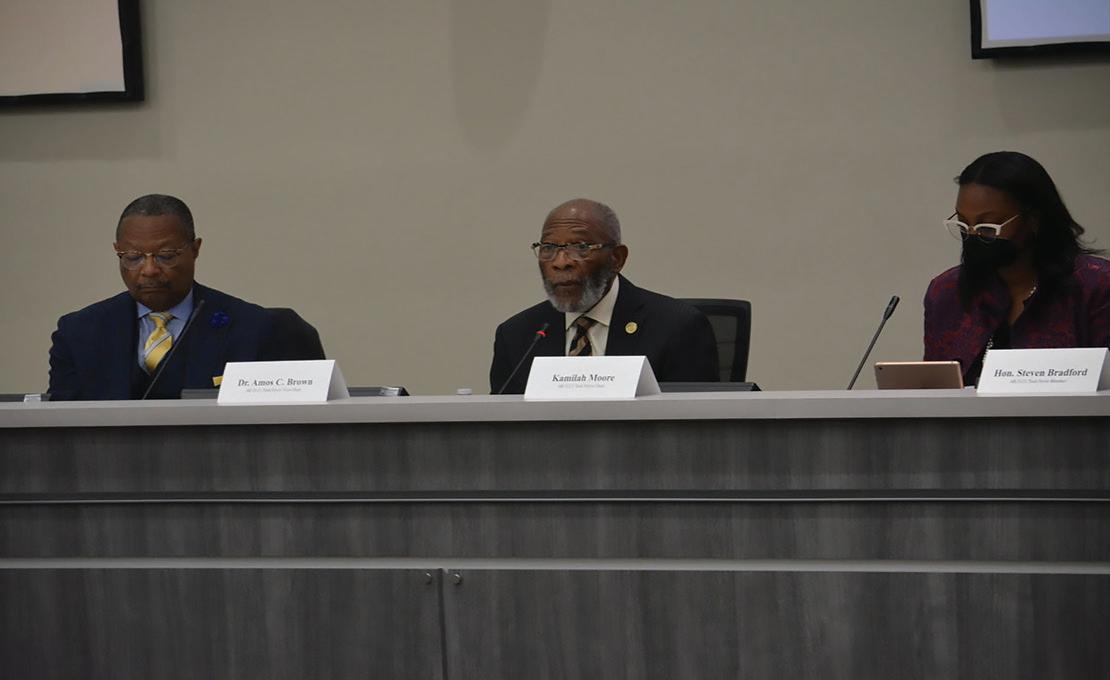
12 minute read
“Then the Lord Said to Samuel…”
By: Lou K. Coleman
CPSC Underscores Need for Consumer Vigilance
Advertisement
WASHINGTON, March
28, 2023 /PRNewswire/ --
The U.S. Consumer Product Safety Commission (CPSC) today released a new report that shows an upward trend in non-fire carbon monoxide (CO) poisoning deaths. The report, Non-Fire Carbon Monoxide Deaths Associated with the Use of Consumer Products
2019 Annual Estimates, covers deaths from 2009 to 2019 Most CO deaths occur in the colder months of the year, with more than half of the deaths occurring during the four cold months of November, December, January and February.
For 2019, there were an estimated 250 consumer productrelated CO deaths in the United States - greater than any other year in the report. EngineDriven Tools (EDTs), including generators, were associated with the largest percentage of non-fire CO poisoning deaths
Heating systems were associated with the second largest percentage of non-fire CO poisoning deaths for 2019. An estimated 69 deaths (28%) were associated with products in this category.
CO is called the invisible killer because it is colorless and odorless and can kill in minutes. CO poisoning can happen so quickly that exposed persons may become unconscious before recognizing the symptoms of nausea, dizziness or weakness.
CPSC urges consumers to take safety precautions to prevent CO poisoning.
Portable Generators
Use portable generators OUTSIDE ONLY, and place them at least 20 feet from the home with exhaust pointed away from any nearby building.
NEVER operate a portable generator inside a home, garage, basement, crawlspace or shed.
Opening doors or windows will not provide enough ventilation to prevent the buildup of lethal levels of CO.
Check that portable generators have been maintained properly, and read and follow the labels, instructions and warnings on the generator and in the owner's manual. Look for portable generators that have a CO shutoff safety feature, which is designed to shut the generator off automatically when high levels of CO are present around the generator. These models may be advertised as certified to the latest safety standards for portable generators–PGMA G300-2018 and UL 2201–which are estimated to reduce deaths from CO poisoning by 87% and 100%, respectively. UL 2201 certified models have reduced CO emissions in addition to the CO shut-off feature.
Heating Products Have a professional inspect all fuel-burning heating products, including furnaces, boilers, fireplaces, wood stoves, water heaters, chimneys, flues and vents each year. These and other heating products can cause CO poisoning if they are improperly installed, poorly maintained, have defective or blocked venting systems or are misused. Clear snow away from the outside vents for fuel-burning appliances such as furnaces so that dangerous carbon monoxide does not build up in the house.
CO Alarms
Working CO alarms save lives!
Install CO alarms on every level of the home and outside sleeping areas. Alarms that are not battery operated should have battery backup in case of a power outage. Interconnected alarms are best because, when one sounds, they all sound. Test the alarms every month to make sure they are working. Replace batteries at least once every year, or install CO alarms with sealed, 10-year batteries.
CPSC resources:
Poster – Carbon Monoxide (CO) the Invisible Killer
Poster – Carbon Monoxide (CO) the Invisible Killer (Spanish)
Infographic - Portable Generator Carbon Monoxide Emissions vs Car Carbon Monoxide Emissions
CPSC PSA: One portable generator produces the same amount of carbon monoxide as hundreds of cars illustrates how gasoline-powered portable generators can create a risk of CO poisoning that can kill in minutes. The PSA is also available in Spanish. Read more safety tips in our Carbon Monoxide Safety Center. Individual Commissioners may have statements related to this topic. Please visit www. cpsc.gov/commissioners to search for statements related to this or other topics.
How the Pandemic Has Affected Attendance at U.S. Religious Services
WASHINGTON, D.C. (March 28, 2023) – Pew Research Center has conducted five surveys since the summer of 2020 in which we asked U.S. adults whether they attended religious services in person in the prior month and, separately, whether they took part virtually (by streaming online or watching on TV). Our analysis of these surveys finds that there are some indications that in-person engagement in religious services has declined slightly since 2019, before the COVID-19 outbreak. The share of all U.S. adults who say they typically attend religious services at least once a month is down modestly but measurably (by 3 percentage points, from 33% to 30%) over that span, and one-in-five Americans say they now attend in person less often than they did before the pandemic.
At the same time, the share of U.S. adults who take part in religious services in some way (in person, virtually or both) in a given month has remained remarkably steady since the early days of the pandemic – even though how they participate has shifted dramatically.
In July 2020 – when many churches, synagogues, mosques and other houses of worship were limiting attendance or closed to physical worshippers – 41% of adults said they had joined in religious services in one of these ways (either in person or virtually) in the past month. Most of them (27% of all U.S. adults) said they had participated only virtually. An additional 9% said they had attended in person and watched virtually. Just 4% said they had gone to church or other religious services only in person in the month prior to the July 2020 survey.
Since then, the total share of U.S. adults participating in religious services has barely budged, hovering around fourin-ten. But as the pandemic has run its course and many religious congregations have reopened their doors to worshippers, the percentage of Americans participating virtually in worship services has been dropping. Meanwhile, in-person attendance quickly rebounded and then appears to have plateaued. In the most recent survey asking these questions, in November 2022, 12% say they participated only virtually in the past month (down from 27% in the first year of the pandemic), while 16% say they attended only in person (up from 4% in 2020). An additional 12% say they did both.
Key takeaways from the new report To assess the impact of the pandemic on worship attendance rates, the report looks at Pew Research Center’s survey data in four different ways:
• Five surveys conducted since the start of the pandemic (beginning with a survey in July 2020) show that a remarkably steady share of Americans –about 40% – say they have participated in religious services in the prior month one way or the other (either in person or virtually, i.e., by streaming online or watching on TV).
Asked directly whether they now attend religious services more or less often than they did before the pandemic, more Americans indicate that their attendance habits have declined than risen. But it’s a complicated picture: As of November 2022, 20% say they are attending in person less often (while 7% say they are going in person more often). On the other hand, 15% say they are participating in services virtually more often (while 5% say they are watching services online or on TV less often).
• The share of U.S. adults who say they generally attend religious services once a month or more has dropped slightly, from 33% in 2019 to 30% in 2022.
• A longitudinal analysis of the survey data – tracking the same individuals’ answers on four annual surveys from 2019 to 2022 – finds that the vast majority (87%) report no change in their rates of worship attendance over that period. But among those who do indicate a change, more report attending services less often (8%) than report attending more often (4%).
Overall, 28% of U.S. adults now say they attended religious services in person in the last month, virtually unchanged from the last time we asked this question in March 2022 (27%) and only slightly higher than in September 2021 (26%). Those surveys indicated a significant rise of in-person attendance from March 2021 (17%) and July 2020 (13%). By contrast, the share of Americans who say they watched religious services online or on TV in the last month dropped in the new survey, from 30% in March 2022 to 24% in November.
Throughout the pandemic, White evangelical Protestants consistently have been the most likely of the country’s major religious groups to attend services in person. The portion of White evangelicals who report that they physically went to church in the past month has not dropped below 30% at any point since July 2020. In the most recent survey, fully half of White evangelicals (52%) say they attended in person. Black Protestants have experienced a substantial bounce in physical attendance, from a low of 14% in July 2020 to 41% in the recent survey. But Black Americans also have suffered a disproportionately high share of COVID-19 hospitalizations and deaths relative to White Americans, and Black Protestants remain the U.S. religious group most likely to be viewing services virtually. In the most recent survey, about half of Black Protestants (54%) say they participated in services online or on TV in the last month, compared with 46% of White evangelical Protestants and smaller shares of Catholics (20%), White non-evangelical Protestants (19%) and Jews (16%). (This report cannot analyze the attendance patterns of Muslims, Buddhists, Hindus and other smaller non-Christian religious groups due to sample size limitations.)
When it comes to party affiliation, Republicans and Republican-leaning independents have been much more likely than Democrats and Democraticleaning independents to attend religious services in person – as well as somewhat more likely to participate virtually – throughout the pandemic.
Older Americans tend to be more religious than young adults, and despite being at greater risk of hospitalization and death from COVID-19, Americans ages 65 and older have generally been somewhat more inclined than young adults (ages 18 to 29)
Lou K. Coleman
“I am about to do a shocking thing... I am going to carry out all my threats ... I have warned continually that judgment is coming [1 Samuel 3:11-14] but they have squandered the opportunities, I have given them to repent. How long will the simple ones love their simple ways? How long will mockers delight in mockery and fools hate knowledge? [Proverbs 1:22]. Hear this, you foolish and senseless people, who have eyes but do not see, who have ears but do not hear.” [Jeremiah 5:21] the time of trouble, which is to increase until the end, is very near at hand. You have no time to lose. The world is stirred with the spirit of war. The prophecies of the eleventh of Daniel have almost reached their final fulfillment. The time of trouble—trouble such as was not since there was a nation [Daniel 12:1]—is right upon you, and you are like the sleeping virgins. Awake from your slumber because soon great trouble will arise among the nations— [fire, flood, earthquake, war, and bloodshed]. Heed the warning before it’s too late!
Christ's second coming and of the destruction to fall upon the world. Run, run to Jesus NOW, for those who heed the warning will be saved. God’s judgment on the earth is a fact. Don’t ignore the warning. The flood is the past example of God’s judgment. Sodom and Gomorrah were destroyed when God rained fire and brimstone on them. God ordered Israel to destroy the Canaanites because of their sin. Israel itself was judged by the Babylonian captivity. Jerusalem was destroyed in A.D. 70 because of rejecting the Messiah. There are many more examples in the Bible. But no other judgment in history was as widespread and severe as that of the flood. As such, the flood stands as the past example, bar none, of the fact of God’s judgment on the whole earth, and just as He judged the whole earth with the flood, so He will judge the whole earth in the end times, and none will escape. Don’t wait until it’s too late! Heed the warning NOW for God’s grace is seen in not closing the door until the last possible moment. Understand God’s future judgment will be historical, universal, and will come suddenly. He who testifies to these things say, “Yes, I am coming quickly.” [Revelation 22:20]. So don’t wait until it is too late. You must take the means of escape God has provided NOW.
to go to religious services in person. Older Americans also report participating in religious services virtually at higher rates than the youngest adults.
The most recent survey, about half of adults 65 and older say they attended services in the past month, including a third who went either only in person (18%) or both in person and virtually (15%). That compares with roughly three-in-ten adults under 30 who say they participated in religious services in any way, including about one-fifth who went either only in person (12%) or both in person and virtually (9%).
Throughout most of the pandemic, about six-in-ten Americans have not taken part in religious services in any way. In the new survey, this includes roughly seven-in-ten adults under 30 (72%) and about nine-in-ten religiously unaffiliated adults (those who describe their religious identity as atheist, agnostic or “nothing in particular”).
These are among the key findings of a new analysis of Americans’ religious attendance, based on a Pew Research Center survey conducted Nov. 16-27, 2022, on the nationally representative American Trends Panel, as well as several older surveys. For the November 2022 survey, a total of 11,377 panelists responded out of 12,402 who were sampled, for a response rate of 92%. The margin of sampling error for the full sample of 11,377 respondents is plus or minus 1.5 percentage points.
To read the report, click here: pewresearch.org/ religion/2023/03/28/howthe-pandemic-has-affectedattendance-at-u-s-religiousservices
Methodology: pewresearch. org/religion/2023/03/28/ pandemic-religious-attendancemethodology Survey topline: pewresearch. org/religion/wp-content/uploads/ sites/7/2023/03/PF_2023.03.28_ pandemic-religion-attendance_ TOPLINE.pdf
For more information about the study or to arrange an interview with the lead researchers, please contact Anna Schiller at aschiller@pewresearch.org or +1-202-419-4514.
Remember the word came to Noah, “Come thou and all thy house into the ark”; The message came to Lot, “Get up," he said. "Get out of this place, for the LORD is about to destroy the city!" [Genesis 7:1; 19:14]. So now we are given warning of
The people watched Noah working for 120 years. They watched the animals streaming in from all parts of the globe. They watched Noah and his family board the ark. The door was still open for any to come aboard. Nobody did. They watched as the Lord shut the door [Genesis 7:16]. The rain started. It was too late.
WITNESS FOR JUSTICE #1144
Closing the Global Gender Digital Divide

Rebekah Choate
The 67th session of the UN Commission on the Status of Women (CSW) was held in New York City between March 6 and 17, 2023. The agreed conclusions adopted by Member States constitute the first comprehensive global blueprint for the rights of women and girls when it comes to technology, innovation, and education in the digital age. This includes access to technology, education in STEAM fields (Science, Technology, Engineering, Art, and Math), and safety and the protection of human rights in digital spaces.
Around the world, there are very few places that are looking at technology and innovation with a gender lens or even attempting to regulate or guide new technology in order to prevent gender, racial, or wealth gaps in access to or education in using these tools. These agreed conclusions will help to guide governments, private companies, and civil society in the creation of new initiatives and tools related to innovation and technology.
The global digital gender divide is pronounced, particularly when it comes to participation and leadership of women and girls and access to and use of technologies, connectivity, digital literacy, and education. We see this through increased violence against women in public life, both in the form of online harassment and physical violence. We see its negative effects on the mental health of young people, particularly girls, who face societal pressure to present their perfect image on social media sites like Instagram.
We saw the digital divide in education starkly during the COVID-19 pandemic. Those with access to laptops or tablets and a high-speed internet connection were able to keep up with their schooling. However, those without access to the internet had to sit in cars in McDonalds or library parking lots for the free Wi-Fi. And if that wasn’t possible, they just dropped out of school. In some places, girls who dropped out of school because of shutdowns were married off so their families didn’t have to worry about not having enough money to take care of them. We have yet to see the data on the full impact of these pandemic restrictions on children and youth, but we do know there will be a disproportionate impact on girls.
The most amazing part of attending CSW either in person or online is the ability to listen to the stories of women from around the world. We are all facing similar challenges and issues, just with different contexts. For example, access to the internet in rural areas of the United States is just as difficult as access in rural areas in other countries. However, the stories of resilience are so inspiring and give me hope that we can create a just world for all.
The UCC fielded a small virtual delegation of women to CSW 67 this year. Keep an eye out for the opportunity to participate in CSW 68 next year. CSW is usually held the first two full weeks of March.
Rebekah Choate is the Minister for Global Advocacy and Education, Global Ministries of the Christian Church (Disciples of Christ) and the United Church of Christ.
12 Mucus-Triggering Foods You Should Avoid This Season
Blackdoctor.org
Black Non-Profit’s Art And Jazz Gala Celebrates 12 Years Of Service To Breast Cancer Survivors And Families

Tip #2: Consume Cucumbers
Cucumbers are rich in potassium, vitamin C, and water. They aid in cleansing the body and reducing inflammation. A great way to add cucumber to your everyday diet is to drink cucumber and lime water throughout the day. Not only does this reduce mucus and inflammation, but it keeps you hydrated and improves the skin.
Tip #3: Find Alternatives






